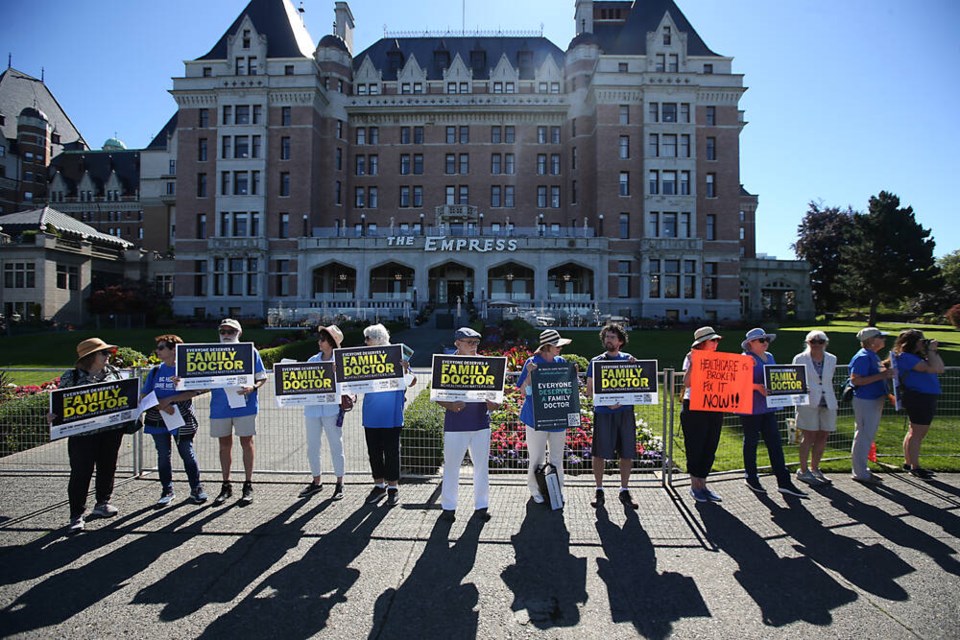A group rallied on the front lawns of the Fairmont Empress on Tuesday to tell premiers meeting inside they want to hear solutions to the chronic shortage of family doctors.
The premiers — on the final day of the Council of the Federation summer meeting — have asked for $28 billion in additional federal health transfers to provinces, representing an increase of the federal share of costs to 35 per cent from 22 per cent.
But Camille Currie, founder of B.C. Healthcare Matters, which advocates on behalf of the one in five British Columbians who do not have a family doctor, said she’s not persuaded increased federal health transfers are the answer if people aren’t told how the new funding will be used.
“I’m not fully convinced that they’re even suggesting that money will be used towards the primary-care crisis because the premier has refused to make a commitment where additional funds will be used,” said Currie.
B.C. Premier John Horgan and his fellow leaders said Tuesday the federal government needs to collaborate with the premiers on a path forward. “We are asking our partners, our federal partners, to join us in something more remotely resembling a 50/50 partnership. I think that’s reasonable. Certainly it’s reasonable to say let’s talk about it.”
Ontario Premier Doug Ford called it “insulting” that the federal government won’t come to the table, while Quebec Premier François Legault said the 13 leaders are saying the same thing: “We cannot afford any more to finance 78 per cent of health-care expenses.”
The federal government released data Monday showing provinces in 2022-2023 will receive health and other major transfers totalling $87.7 billion.
B.C. will receive $8.4 billion in transfers in 2022-2023, it said, noting the province received a one-time top-up of $67.5 million in 2019-20 and $541.8 million in 2020-21 to support the response to COVID-19.
In March, the federal government announced an additional $2 billion one-time top-up to provinces and territories, distributed equally per capita, in addition to the extra $4.5 billion Canada Health Transfer top-up provided since the start of the pandemic.
Ottawa has suggested it would want accountability for how the extra health transfers are used.
But Horgan said provinces and territories are accountable every day in legislatures and budgeting processes, adding needs vary by province. A province with a higher senior population will direct more health-care dollars to long-term care, for instance.
Northwest Territories Premier Caroline Cochrane said the federal funding needs to be flexible. “Don’t tell me that I have to spend it on long-term care when I don’t have a doctor or nurse in our communities — every jurisdiction is different,” said Cochrane.
How health-care funding is spent in B.C. is the subject of debate.
The Canadian Medical Association and doctors’ groups have argued Urgent and Primary Care Centres paying doctors on salary have drawn physicians and funding away from family practice, for example.
About five medical clinics have closed in the capital region since January and UPCCs in Victoria are often full by 8:30 a.m.
Horgan applauded those rallying for improved health care, but noted that the primary-care crisis is not confined to B.C., as “millions and millions of Canadians” don’t have access to a family doctor. The Canadian Medical Association says five million Canadians do not have primary-care providers.
Horgan said filling vacancies and building up post-secondary training spots for doctors, nurses, and nurse practitioners requires a national approach and “a steady flow of revenues.”
The UPCCs the province is developing are “a stopgap” to take pressure off the province’s acute-care system, he said, “while we find a way forward with Doctors of B.C. and others to make sure we find the right balance between a fee-for-service system, which many doctors support, and a salary process, which many doctors support.”
The fee-for-service model pays doctors a basic amount of $32 for each patient visit, from which physicians usually pay overhead costs, sometimes as much as $100,000 a year per clinic.
“There’s not unanimity within the profession — therefore we have to sit down and work these things out, and we’re doing that,” said Horgan.
B.C. Green Party Leader Sonia Furstenau said the B.C. government is asking for cash with no plan on how to solve the family-doctor crisis and if the federal transfer is increased, it should require clear outcomes, including a family doctor for every British Columbian who wants one and free access to medical records.
Currie also wants to hear exactly what the plan is to fix the primary-care system in B.C., how much it will cost or if it simply means readjusting the budget, and how the requested additional federal dollars would be spent.
”It’s not our position to create the solutions — it is theirs and we’re just anxiously waiting to hear what they will do and until then, we’re going to keep demonstrating and making our point clear that everyone in B.C. deserves timely access to a family doctor.”






